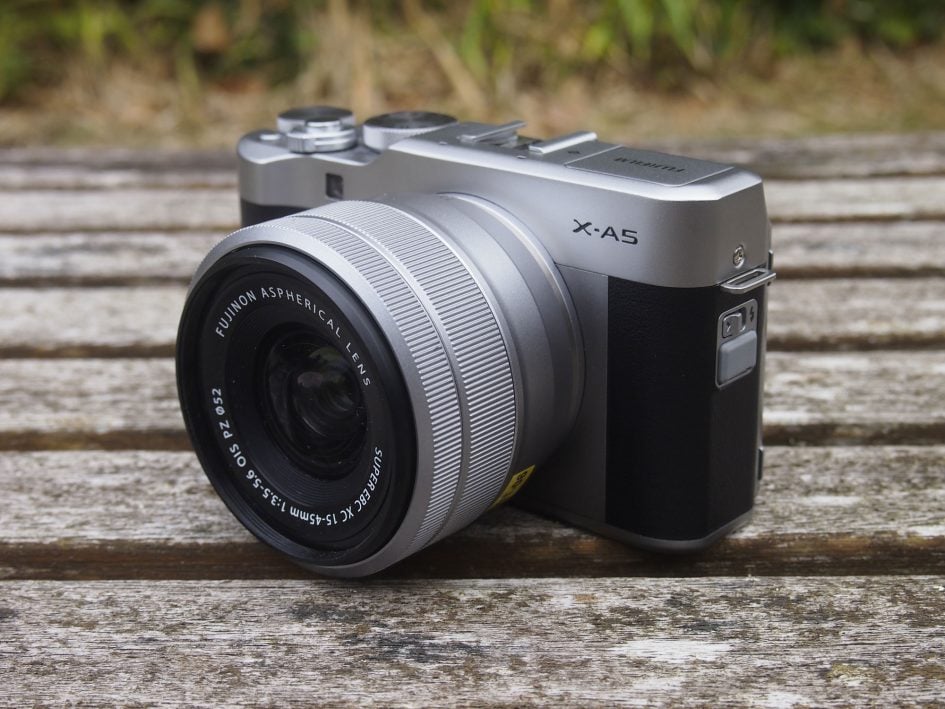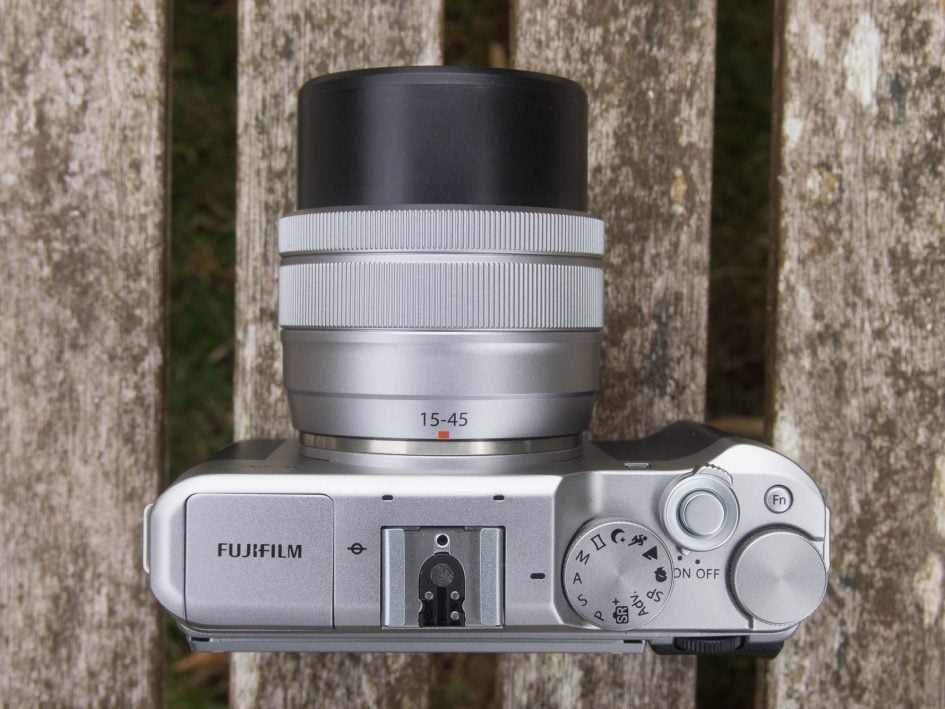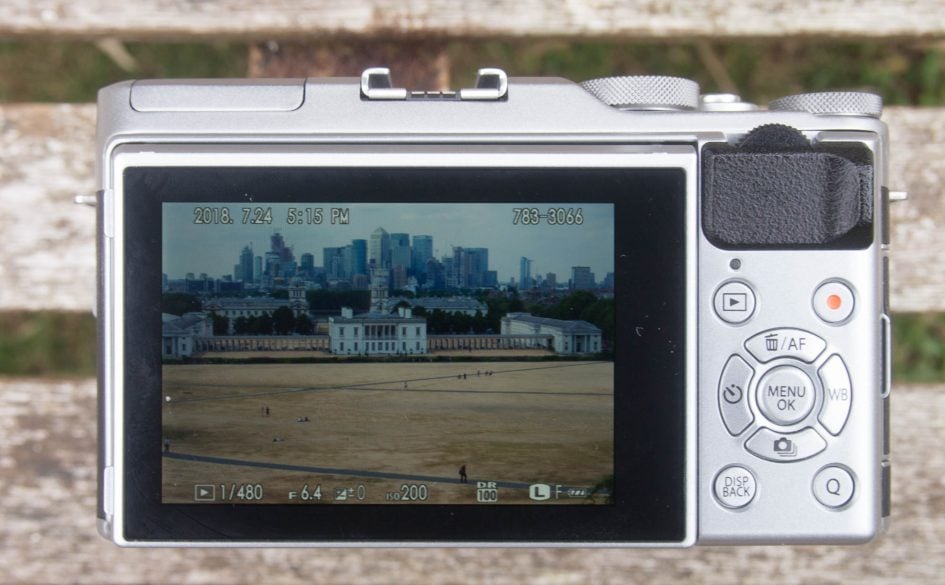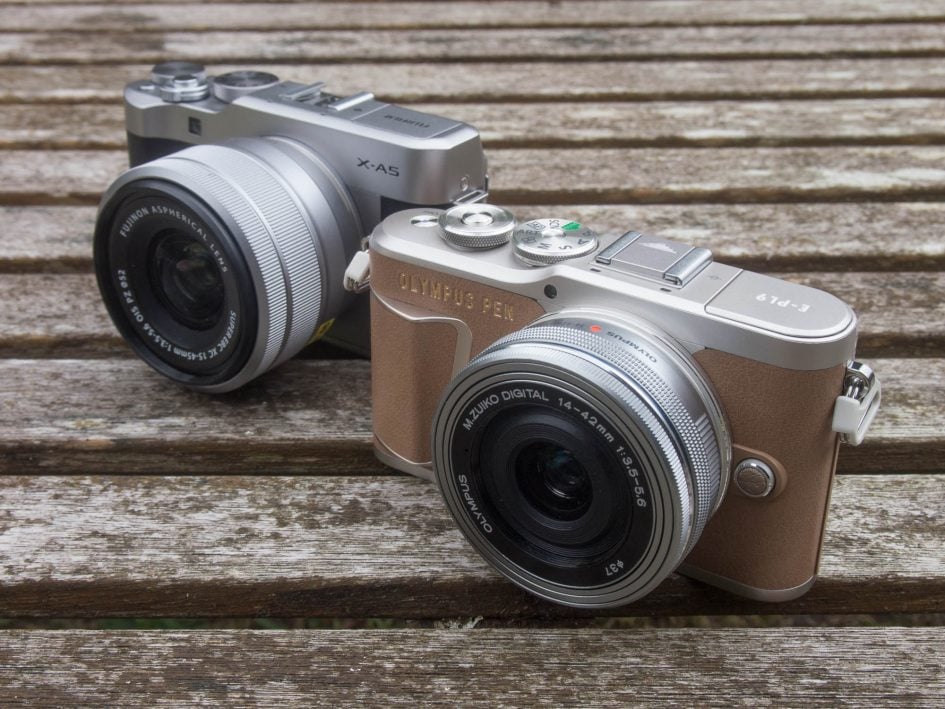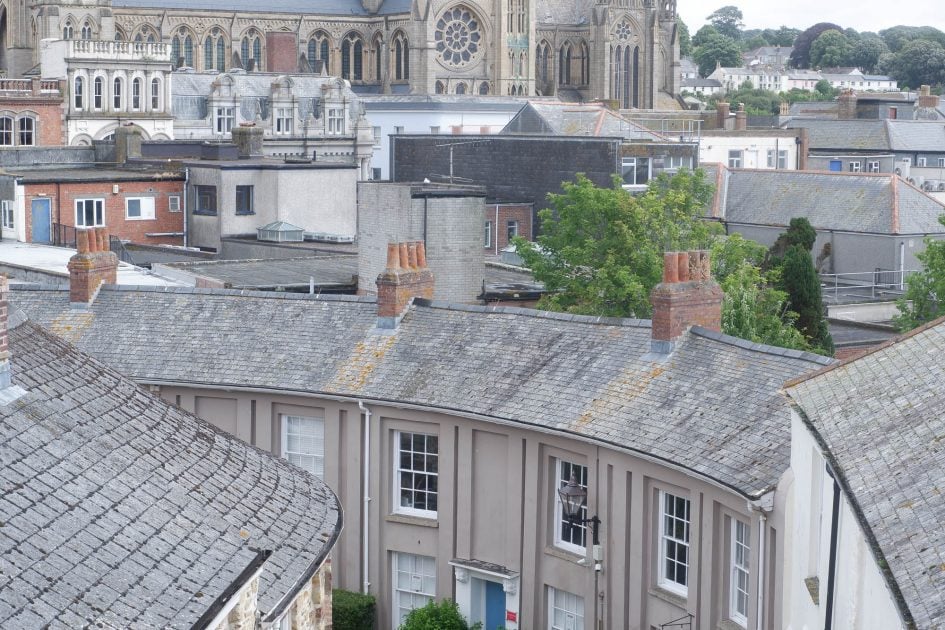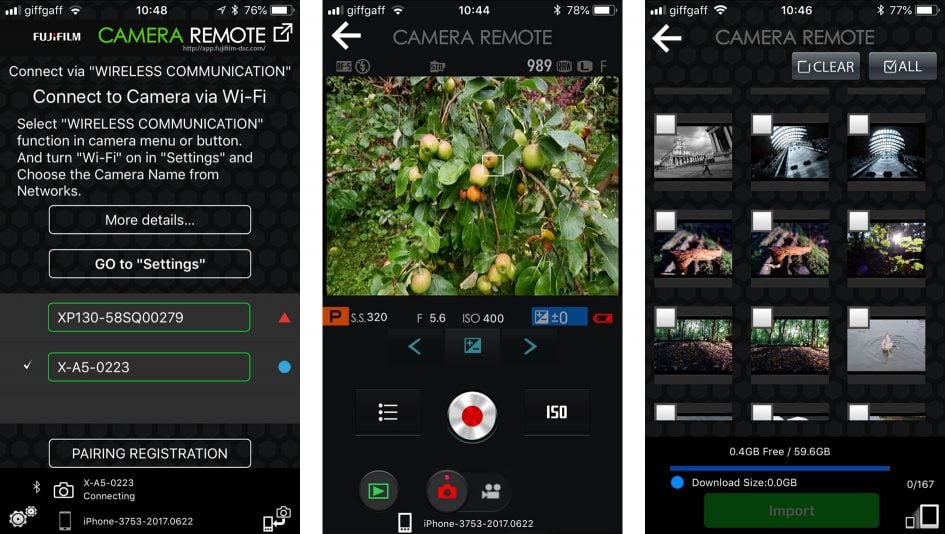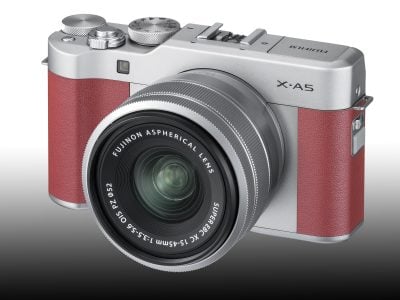Fujifilm XA5 review
-
-
Written by Ken McMahon
Intro
The Fujifilm XA5 is an affordable entry-level mirrorless camera aimed at beginners and social photographers, sporting a 24 Megapixel APSC sensor, tilting touchscreen, Bluetooth and Wifi. Announced in February 2018 it comes roughly a year and a half after the previous XA3 and no, you’re not going mad, there wasn’t an XA4 in-between.
The XA5 is the smallest and lightest body in Fujifilm’s X-series, measuring 117x68x40mm and weighing 361g including battery. It features a new 24 Megapixel CMOS sensor that like the XA3 before it may not sport Fujifilm’s X-Trans technology, but now at least includes embedded phase-detect autofocus, allowing it to more confidently refocus than its predecessor. Battery life has been extended to around 450 shots per charge, 4k video is now available, albeit pretty limited at 15fps and for only five minute clips, while 1080p is available up to 60p for 14 minute clips. If you film in 720p, you can shoot up to 27 minutes per clip, or at high frame rates for up to a four times slowdown. There’s also a mic input which makes it an interesting option for vloggers, although as a 2.5mm jack you’ll need an adapter for most 3.5mm accessories and if you fold the screen up for selfie-filming, you’ll block the hotshoe. The Olympus PEN E-PL9 gets around this problem by flipping the screen forward underneath, rather than above the camera body, although this in turn blocks the tripod thread.
The XA5 is also now equipped with Bluetooth to aid Wifi negotiation. Perhaps most excitingly for the target audience, the XA5 is supplied in a kit with a brand new lens: the XC 15-45mm f3.5-5.6 which is the first X-mount zoom to offer a motorised zoom, making it ideal for video work. So the main upgrades over the XA3 are phase-detect autofocus, Bluetooth and the (limited) 4k video, plus the new kit zoom. In my review I’ll test the new features, see how it measures-up for the target audience, and how it compares to key rivals including the Olympus PEN E-PL9. So if you’re looking for an entry-level mirrorless camera, read on!
Like all Fujifilm’s mirrorless models, the X-A5’s design has a timeless classic look about it. The body has almost the exact same dimensions as the Olympus PEN E-PL9 and in fact the E-PL9 is a little heavier. However, the X-A5’s new powered zoom is substantially larger than the 14-42mm powered zoom on the E-PL9, making for a bigger overall package as you can see in the comparison a little further below. The front panel is uncluttered with only the AF LED to break the smooth lines and there’s a comfortable grip on the right, though your little finger will dangle off the bottom. It’s manageable with one hand, but feels a lot more secure with your left hand supporting the lens.
On the top panel the mode dial has the usual PASM positions, as well as SR+ auto mode, scene modes, Advanced filters, some dedicated scene mode positions and Motion panorama. The on/off switch surrounds the shutter release and in front of the top control dial is the X-A5’s single reprogrammable function button.
Round the back there’s a second control dial which is operated with your shooting finger. In most modes the top dial controls exposure compensation and this one does aperture or shutter speed in A and S modes. In manual exposure mode the top dial controls the shutter speed and the rear one the aperture. Alongside the flip-up screen are a four-way controller with the menu button at the middle, movie record button, playback button, display overlay/back button and a Quick menu button. On the right of the body is a door to the mini HDMI and USB ports – the latter can be used to charge the battery in-camera – and on the left, under the flash button is a 2.5mm mic socket. Composition is entirely with the screen which can angle upwards by 180 degrees to face you for selfies or vlogging, although doing so will block the hotshoe, preventing you from mounting an external microphone. If you like the style, features and quality of the X-A5 but want a viewfinder and a screen that can face the subject without blockages, then consider the slightly higher-end X-T100 – see my Fujifilm X-T100 review for more details.
Seen side-by-side here you can see that there’s little to separate the X-A5 and E-PL9 in terms of size and weight, at least as far as the body goes. Because of its physically larger APS C sensor The X-A5’s X-system lenses are a little larger than the E-PL9’s Micro Four Thirds lenses. In practical terms this means you can comfortably fit the E-PL9 with its powered kit lens in a coat, or even jacket pocket, but the X-A5 is more of a handful. With the cameras powered off and the lenses retracted (as they are in this shot) the E-PL9’s depth is 60mm compared with 83mm for the X-A5.
The X-A5 ships with Fujifilm’s new Fujinon XC 15-45mm f3.5-5.6 OIS PZ lens. With a 35mm equivalent range of 23-69mm this lens is really well suited for selfie shooting and vlogging. with the camera held at arms length (and the screen flipped forwards so you can see what you’re doing) you can fit yourself in head and shoulders quite comfortably. Of course the 23mm equivalent wide angle is also great for large groups and small interiors.
This is the angle of view with the lens zoomed to its maximum 45mm, or 69mm equivalent focal length. This isn’t going to get you close to distant sporting action or wildlife, but it’s a good focal length for portraiture. The 14-42mm lens on the E-PL9 has a 35mm equivalent range of 28-84mm so it doesn’t go as wide as the X-A5’s lens, but it can go a little longer. If you aim to do a lot of vlogging and selfie shooting that extra margin at the wide angle end is going to be very useful.
The XC 15-45mm has a quoted close focus distance of 13cm at its 15mm wide angle setting, but I was able to shoot as close as 45mm from the subject as you can see from the shot above. It would have been great to get a little bit closer to this small butterfly but I’m fairly happy with this result. With the 14-42mm EZ lens on the E-PL9 I could only get to within 85mm of the subject, which would rule out a shot like this.
Fujifilm applies its picture styles using a set of Film Simulations that emulate classic Fujifilm film stock. The default setting is Provia, and that’s what you’ll see in all my sample images unless otherwise stated; it delivers a good balance of contrast and colour without being too punchy or saturated. If you fancy something more vivid, then choose Velvia, or for a more subdued look, Astia, while portrait photographers may like Pro Neg Hi and Standard. For a classy vintage look, try Classic Chrome or Sepia or one of the four monochrome modes, three of which feature yellow, red and green filters. You won’t however get the Acros Simulation as it’s reserved for bodies employing X-Trans III sensors.
For this clip I set the Fujifilm X-A5 to its 1080 / 60p video mode with the stabilisation enabled. As you’d expect the exposure and colour are good and the stabilisation keeps things reasonably steady, though the horizontal pan has a jitter that I’m not entirely sure is all my own doing. The 15-45mm lens has a two-speed zoom and it can be tricky to turn the ring just the right amount to engage either the slow or faster speed. Here I managed to zoom in at the faster speed and zoom out at the slower one. There’s a slight audible buzz from the zoom motor, something you could avoid by using an external microphone plugged into the 2.5mm mic socket.
Again in 1080 / 60p mode, and with the stabilisation on, this low-light indoor pan looks good in terms of the noise quality. Probably because of the daylight coming through the open doors, the white balance is overly warm to begin with, then the X-A5 makes quite a drastic over-correction, something I could have avoided by setting the white balance beforehand, rather than leaving it on the default auto setting.
For this vlogging clip the Fujifilm X-A5 is again in 1080 / 60p mode, with the lens set to the 15mm maximum wide angle and the screen flipped into the forward facing position. I attached a small gorillapod to the X-A5 to make it easier to hold, but in retrospect I probably could have done without it. And with the camera held at arms length and facing you it’s fairly easy to press the movie record button with your index finger. It’s a shame the screen prevents you using the hot shoe when it’s facing forwards as that rules out fitting an external flash or mic in it. The higher-end XT100 has the advantage here as its screen can fold out sideways to face the subject, leaving the hotshoe and tripod thread clear for use.
Finally, here’s a short clip recording in the X-A5’s 4K / 15p mode. As you see 15 frames per second isn’t fast enough to give the impression of smooth continuous motion and the footage looks very jumpy. This rules the 4K mode out for normal video recording, but it does provide the X-A5 with some capable 15fps burst shooting modes including a ‘multi focus’ mode that allows you to select the focus point post shooting – it’s very similar to the Post Focus mode that Panasonic has provided on its models for some time.
The X-A5 has built-in Wifi and Bluetooth. The Wifi connection allows you to remote shoot, browse images on the camera card and download them to a smartphone or computer. The Bluetooth connection in theory allows automatic transfer images to your phone over Wifi, though I was unable to get this feature to work at all during testing with my iPhone 6. Using the Fujifilm Cam Remote app with the X-A5 wasn’t entirely a joy-filled experience. The app is slow to respond when browsing images and, as I’ve said, didn’t work for me in auto transfer. In remote shooting mode it provides some control over shooting settings and you can record video, but I was a little disappointed there was no option to zoom the lens. Gordon’s used the Bluetooth on the X-T100 to embed updated locations as he shot and this feature should also work on the X-A5.
Shift the X-A5’s mode dial to the Motion Panorama position and you can shoot panoramas with the camera in portrait or landscape orientation, rotating as you hold down the shutter release. There are 120 and 180 degree options which, with the camera in landscape orientation, produce files measuring 6400×1440 pixels and 9600×1440 pixels respectively. With the camera in portrait orientation it’s 2160 pixels rather than 1440.
Check prices on the Fujifilm X-A5 at Amazon, B&H, Adorama, or Wex. Alternatively get yourself a copy of my In Camera book or treat me to a coffee! Thanks!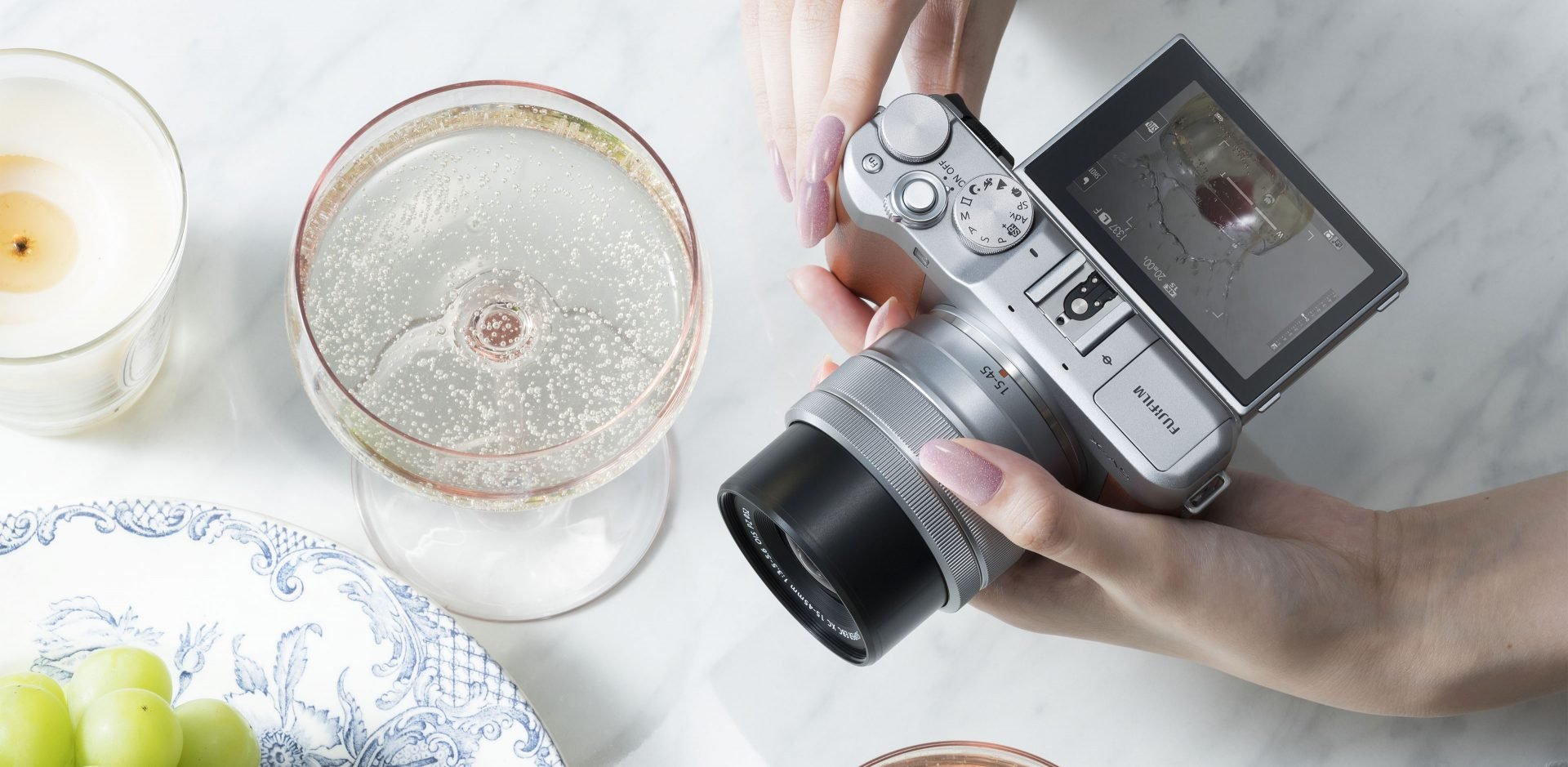
 The Fujifilm X-A5 is an entry-level mirrorless system camera aimed at beginners, social photographers and vloggers. It has a 24 Megapixel APSC sensor and typically sold with a powered kit zoom. The sensor sports a hybrid AF system which works well for stills shooting, albeit less confidently for video. The touch screen flips up to face forward for selfies and it also sports an external microphone input, although annoyingly it's a non-standard 2.5mm jack and the hotshoe becomes blocked when the screen's facing forward which makes it less convenient for vloggers. You should also take the 4k capability with a pinch of salt as it only operates at 15fps which isn't fast enough for smooth motion, but it remains useful for some burst modes. The highlight of the X-A5 though is Fujifilm's image processing which - even without one of its X-Trans sensors - inside remains as good as the best models in its class. Recommended, but compare closely with the Sony A5100, Canon EOS M100 and Olympus E-PL9, not to mention Fujifilm's own slightly higher-end X-T100.
The Fujifilm X-A5 is an entry-level mirrorless system camera aimed at beginners, social photographers and vloggers. It has a 24 Megapixel APSC sensor and typically sold with a powered kit zoom. The sensor sports a hybrid AF system which works well for stills shooting, albeit less confidently for video. The touch screen flips up to face forward for selfies and it also sports an external microphone input, although annoyingly it's a non-standard 2.5mm jack and the hotshoe becomes blocked when the screen's facing forward which makes it less convenient for vloggers. You should also take the 4k capability with a pinch of salt as it only operates at 15fps which isn't fast enough for smooth motion, but it remains useful for some burst modes. The highlight of the X-A5 though is Fujifilm's image processing which - even without one of its X-Trans sensors - inside remains as good as the best models in its class. Recommended, but compare closely with the Sony A5100, Canon EOS M100 and Olympus E-PL9, not to mention Fujifilm's own slightly higher-end X-T100.